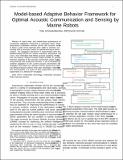| dc.contributor.author | Schneider, Toby | |
| dc.contributor.author | Schmidt, Henrik | |
| dc.date.accessioned | 2015-07-08T15:24:08Z | |
| dc.date.available | 2015-07-08T15:24:08Z | |
| dc.date.issued | 2013-07 | |
| dc.date.submitted | 2012-10 | |
| dc.identifier.issn | 0364-9059 | |
| dc.identifier.issn | 1558-1691 | |
| dc.identifier.uri | http://hdl.handle.net/1721.1/97709 | |
| dc.description.abstract | In this paper, a hybrid data- and model-based autonomous environmental adaptation framework is presented which allows autonomous underwater vehicles (AUVs) with acoustic sensors to follow a path which optimizes their ability to maintain connectivity with an acoustic contact for optimal sensing or communication. The adaptation framework is implemented within the behavior-based mission-oriented operating suite-interval programming (MOOS-IvP) marine autonomy architecture and uses a new embedded high-fidelity acoustic modeling infrastructure, the generic robotic acoustic model (GRAM), to provide real-time estimates of the acoustic environment under changing environmental and situational scenarios. A set of behaviors that combine adaptation to the current acoustic environment with strategies that extend the decision horizon beyond that of typical behavior-based systems have been developed, implemented, and demonstrated in a series of field experiments and virtual experiments in a MOOS-IvP simulation. | en_US |
| dc.description.sponsorship | United States. Office of Naval Research (Grant N00014-08-1-0011) | en_US |
| dc.description.sponsorship | United States. Office of Naval Research (Grant N00014-08-1-0013) | en_US |
| dc.description.sponsorship | NATO Undersea Research Centre (NURC) | en_US |
| dc.language.iso | en_US | |
| dc.publisher | Institute of Electrical and Electronics Engineers (IEEE) | en_US |
| dc.relation.isversionof | http://dx.doi.org/10.1109/JOE.2012.2232492 | en_US |
| dc.rights | Creative Commons Attribution-Noncommercial-Share Alike | en_US |
| dc.rights.uri | http://creativecommons.org/licenses/by-nc-sa/4.0/ | en_US |
| dc.source | Other repository | en_US |
| dc.title | Model-Based Adaptive Behavior Framework for Optimal Acoustic Communication and Sensing by Marine Robots | en_US |
| dc.type | Article | en_US |
| dc.identifier.citation | Schneider, Toby, and Henrik Schmidt. “Model-Based Adaptive Behavior Framework for Optimal Acoustic Communication and Sensing by Marine Robots.” IEEE J. Oceanic Eng. 38, no. 3 (July 2013): 522–533. | en_US |
| dc.contributor.department | Massachusetts Institute of Technology. Center for Ocean Engineering | en_US |
| dc.contributor.department | Massachusetts Institute of Technology. Department of Mechanical Engineering | en_US |
| dc.contributor.department | Woods Hole Oceanographic Institution | en_US |
| dc.contributor.mitauthor | Schneider, Toby | en_US |
| dc.contributor.mitauthor | Schmidt, Henrik | en_US |
| dc.relation.journal | IEEE Journal of Oceanic Engineering | en_US |
| dc.eprint.version | Original manuscript | en_US |
| dc.type.uri | http://purl.org/eprint/type/JournalArticle | en_US |
| eprint.status | http://purl.org/eprint/status/NonPeerReviewed | en_US |
| dspace.orderedauthors | Schneider, Toby; Schmidt, Henrik | en_US |
| dc.identifier.orcid | https://orcid.org/0000-0003-3422-8700 | |
| mit.license | OPEN_ACCESS_POLICY | en_US |
| mit.metadata.status | Complete | |
